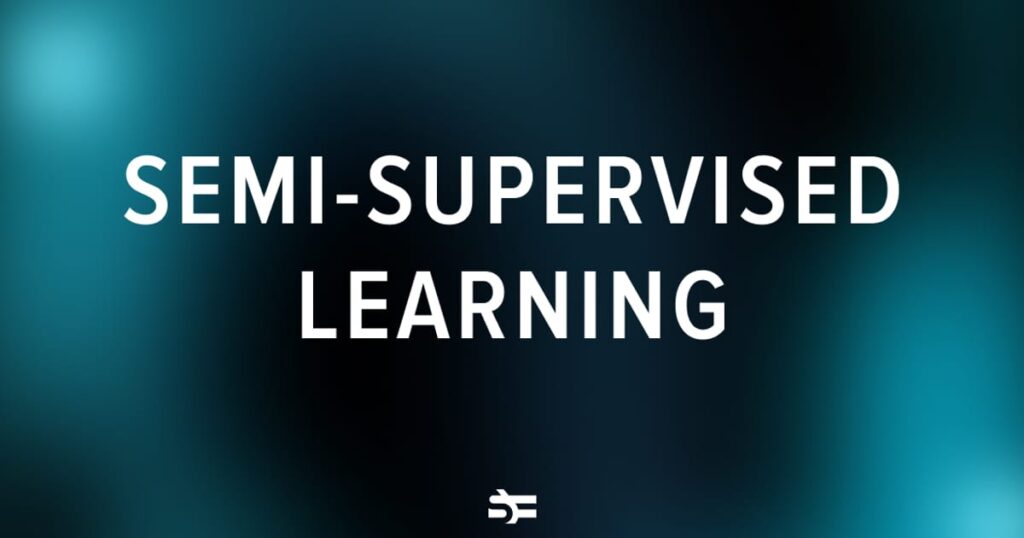In previous blog posts, we delved into different types of machine learning such as supervised and unsupervised learning. Today, we will further explore hybrid, or semi-supervised learning, which is known for its versatility and widespread use in machine learning.
This article will cover how semi-supervised learning functions, its advantages, and the recommended algorithms to use.
The definition of semi-supervised learning

If you’re familiar with supervised and unsupervised learning, you know that these models rely on labeled and unlabeled data for training, respectively. Semi-supervised learning, on the other hand, combines both labeled and unlabeled data during the training process to enhance model performance.
This approach proves beneficial when there is a scarcity of labeled data, allowing the model to leverage unlabeled data without compromising accuracy.
How does semi-supervised learning work?
Semi-supervised learning utilizes techniques like self-training, co-training, and multiview learning to train models effectively.
Self-training
In self-training, a model is initially trained on a small labeled dataset. It then predicts labels for unlabeled data, incorporating confident predictions into the labeled set for subsequent training iterations.

This method is valuable when labeled data is limited but there is an abundance of unlabeled data. It allows the model to expand the labeled dataset using its own predictions on unlabeled instances.
Additionally, self-training is effective when labeled data becomes available gradually or in batches, enabling the model to iteratively improve.
For instance, in healthcare, where labeling medical records can be costly and demanding, self-training can be used to expand the labeled dataset.
Co-training

Co-training involves training a model on multiple views of the data, each associated with a different feature set. The models exchange information during training to leverage each other’s strengths.
This method is beneficial when the dataset contains redundant or complementary features, allowing each model to capture unique data aspects and enhance overall learning.
Co-training is particularly useful in tasks involving multiple modalities, such as multimedia analysis.
For example, in developing self-driving cars, co-training can help analyze information from various sensors and cameras to enhance performance.
Note: Co-training differs from multi-view learning in that co-training already has grouped feature representations, whereas multi-view learning usually discovers these representations.
Multi-view learning

Multi-view learning aims to improve model performance by considering multiple representations of the data and integrating information from these views to enhance the model’s understanding of underlying patterns.
For example, a content recommendation system can use various modalities like text, computer vision, and user behavior data to classify and label content effectively.
Specific cases of multi-view learning include:
Assumptions in semi-supervised learning
Semi-supervised learning relies on certain assumptions about the unlabeled data to make accurate predictions.
Cluster assumption
The cluster assumption suggests that points close to each other in the input space likely share the same label or belong to the same class. This assumption aids models in understanding the data distribution’s underlying structure.
Semi-supervised learning algorithms leverage this assumption to extend information from labeled to unlabeled data, assuming that neighboring points in the input space have similar labels.
However, the cluster assumption may not be effective for complex data structures or overlapping classes, requiring alternative methods in such cases.
Smoothness assumption
The smoothness assumption posits that decision boundaries between classes in the input space should be smooth and continuous. This assumption is crucial in scenarios where only a small portion of the data is labeled, requiring the algorithm to generalize well across the entire dataset.
Low-density assumption
The low-density assumption suggests that decision boundaries between classes typically reside in low-density regions of the data distribution. Sparse data regions are more likely to represent transitions between distinct clusters or classes.
Manifold assumption in semi-supervised learning
The manifold assumption implies that high-dimensional data residing in a lower-dimensional manifold can be effectively represented and learned. This assumption allows algorithms to extend patterns learned from labeled instances to nearby unlabeled instances.
Applications of hybrid learning
Semi-supervised learning finds applications across various fields.
1. Computer vision
Semi-supervised learning has transformed computer vision by improving accuracy and robustness in tasks like image classification, object detection, and segmentation, where labeled datasets are limited.
2. Natural language processing (NLP)
Hybrid learning has proven valuable in NLP tasks such as sentiment analysis and language modeling by pre-training models on unlabeled text data and fine-tuning on smaller labeled datasets.
3. Medical imaging
Semi-supervised learning is increasingly used in medical imaging for tasks like tumor detection and disease classification, leveraging unlabeled data to enhance diagnostic capabilities.
4. Anomaly detection
In cybersecurity and fraud detection, semi-supervised learning aids in identifying anomalous patterns within large datasets by training on normal behavior and learning from unlabeled data.
5. Speech recognition
Semi-supervised learning improves speech recognition systems by adapting to diverse speaking styles and accents through labeled and unlabeled audio data.
6. Autonomous vehicles
Hybrid learning assists in tasks like object detection and scene understanding in self-driving cars by learning from annotated and unannotated data.
7. Finance and fraud detection
In financial industries, semi-supervised learning is crucial for detecting fraudulent activities with limited labeled instances, relying on unlabeled data to improve fraud detection.
8. Drug discovery
Semi-supervised learning aids in drug discovery by analyzing molecular structures and predicting potential drug candidates using vast amounts of unlabeled chemical data.
Conclusion
Semi-supervised learning optimizes available resources, tackles labeling constraints, and expands the possibilities for machine learning applications. As advancements in this field continue, semi-supervised learning will undoubtedly play a vital role in enhancing artificial intelligence systems’ capabilities.
For more information, continue reading:


